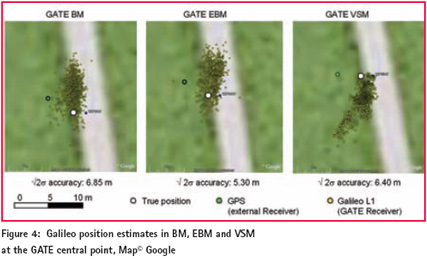| GNSS | |
GATE: A boon for Galileo
|
Guenter Heinrichs,Erwin Loehnert,Elmar Wittmann,Roland Kaniuth
|
|||||||||||||||||||||||||||||||||
|
The experiment was performed in the GATE Base Mode and Extended Base Mode as well as in Virtual Satellite Mode, where the GATE/Galileo signals are simulated as they were transmitted from orbiting satellites. In fact of course the signals are transmitted by the earth fixed transmitters, so that signal fading and multipath effects, due to building and the landscape, are still present. The viewgraphs in Figures 4 show the position solutions on L1 frequency. Dynamic field tests The sample results of a test drive in the GATE mode VSM are presented in fig. 5. The dynamic positioning tests of the GATE receiver with Galileo signals in the GATE test area gave proof of the operational capability as well as the performance of the receiver and the whole The acceleration values during the relevant parts of the test runs were in the range from about 15 to 20 seconds for speeding up from 0 to about 100 km/h. Also under these conditions regular Galileo position updates were obtained. Slight outages in the position solution, as seen in Figures 6 are the result of a conventional epoch by epoch data processing of the GATE User Terminal Software. For estimation of the position solution a standard leastsquares approach is used to get unfiltered solutions for each single epoch. A Kalman- Filter or dead-reckoning algorithm as it is implemented in common low cost GPS receivers would smooth such outliers in the position solution. For the position estimates illustrated in this paper even no carrier smoothing was applied to smooth the pseudo-ranges obtained from the code measurements from only data channels. Hence, any degradation of the measurements’ quality due to e.g. signalshading, as it is the case in the wooded part of the road in the fig. 5, strongly effects the quality of the position solution. Regarding the illustrated tests in this paper it should be pointed out, that in all operational modes of the GATE system the receiver has at maximum six GATE transmit stations in view. Due to the vegetation and housing in the GATE test area and the low elevation angles of the transmitters in view at the user receiver position, shading of lines of sight to the transmitters occurs very often, while moving through the test area. Position outliers are often caused due to heavily degraded HDOP values, especially in VSM mode, when the remaining (not shaded) lines of sight represent a satellite constellation where the satellites and the user form a polyhedron with a very small volume (e.g. the satellites are situated nearly in one line from the users point of view). To a certain extent such scenarios can be evaded by an elaborate configuration of the virtual satellite constellation to be applied. However, it is not possible to completely avoid such cases, because this would result in too frequent PRN switches of the transmitters. A PRN switch will decrease the number of potential available measurements at least for the time that is needed to receive the whole navigation message of the “new” satellite (at least 50 seconds for F/ Nav and 15 seconds for I/Nav messages). ConclusionsGATE is a terrestrial test environment for developers of Galileo (Galileo/GPS) receivers, applications and services. The test range is situated in the region of Berchtesgaden/Germany. GATE is currently running in trial operation and will be fully operational soon. The terrestrial test bed is considered to be a necessary intermediate step for Galileo from laboratory into orbit in terms of realistic RF signal transmission. It will not only support signal validation by providing valuable data but also provide insight in building a ranging system, simply by building it. This contributes to mitigate risks in the development of Galileo. Currently further tests and optimisations with respect to environmental conditions are being performed. GATE will provide the opportunity for receiver, application and service developers to perform realistic field-tests of hardware and software for Galileo at an early stage, i.e. several years before the full operability of Galileo. And last but not least, GATE will allow full endto- end testing of unmodified / commercial Galileo receivers. For further information on GATE please refer to the official project homepage http://www.gate-testbed.com. AcknowledgmentsGATE is developed on behalf of the DLR (German Aerospace Center, Bonn- Oberkassel) under contract number FKZ 50 NA 0604 with funding by the BMWi (German Federal Ministry of Economics and Technology). This support is greatly acknowledged. |
|||||||||||||||||||||||||||||||||
|
|||||||||||||||||||||||||||||||||
|
Pages: 1 2


















 (No Ratings Yet)
(No Ratings Yet)




